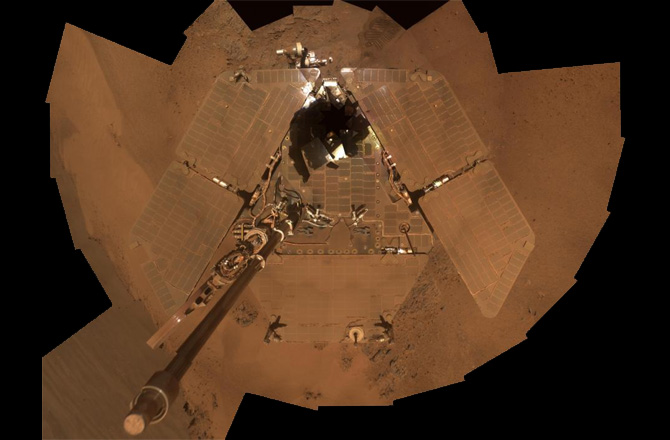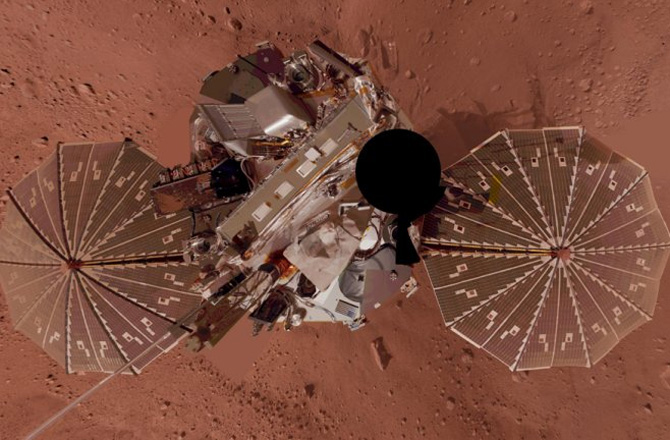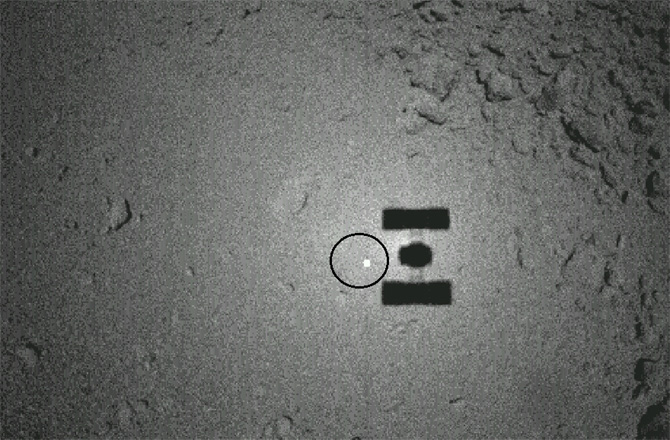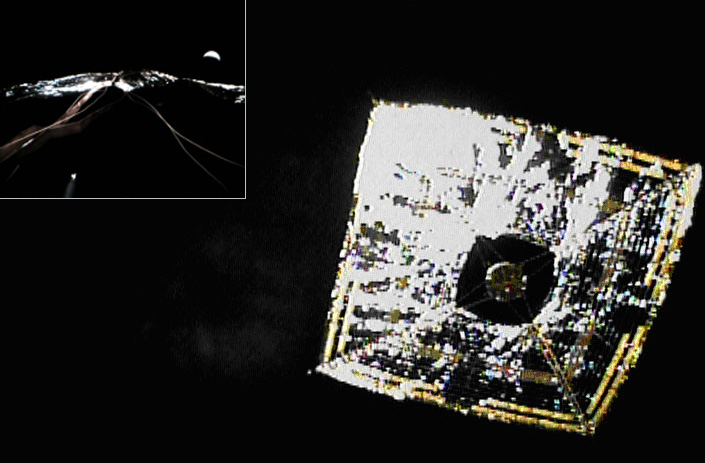Photos: Top 10 Space Robot 'Selfies'
Curiosity, 2012
'Selfies' are all the rage these days. Every smartphone is attached with a camera and to the Internet, so it was inevitable that our vain species would take full advantage of the technology, snapping endless photos of cats and, of course, ourselves. Selfies -- or 'self portraits' to the uninitiated -- have become such a cultural phenomenon that Oxford University Press has declared 'Selfies' their word of the year. This may sound asinine, but Merriam-Webster Dictionary balanced it out and declared 'Science' their word of 2013.
In the spirit of fairness, I've combined the two words of the year and applied them to robots. Yes, robots. Robots that explore space, doing science. And just in case you didn't know, robots can be pretty vain too, taking snapshots of their junk for the whole Internet to see. To narrow the field down a bit, I've only selected robots that have photographed parts of their own structure, or attached components. I've also allowed the occasional robotic camera that was deployed for the sole purpose of taking a selfie (nice effort, IKAROS).
The first robot that likely comes to mind is the undisputed King of Selfies, NASA's Mars Science Laboratory rover Curiosity. The car-sized rover impressed the world with its selfie prowess when mission scientists released a stunning high-resolution mosaic of the rover in November 2012, only a couple of months after it landed inside Gale Crater. Curiosity achieved the feat by holding its Mars Hand Lens Imager (MAHLI) at (robotic) arm's length, taking a truly authentic "selfie." The world applauded this effort.
PHOTOS: Mars Through Curiosity's Powerful MAHLI Camera
Viking 2, 1976
But Curiosity certainly wasn't the first robot on Mars to snap its own picture, and it won't be the last. Although the Viking landers that touched down on the Red Planet in 1976 didn't have robotic arm-mounted cameras capable of taking a "true" selfie, they did their best. This view from Viking 2 was snapped on Nov. 2, 1976, showing a part of the lander's deck, the American flag, the bottom of the robot's high-gain antenna and a boulder-littered Utopia Planitia, the largest identified impact crater on Mars. Stunning.
PHOTOS: Alien Robots That Left Their Mark on Mars
Spirit, 2005
Staying on Mars, some amazing panoramic shots and top-down self portraits have been attained by NASA's epic twin Mars Exploration Rovers Spirit and Opportunity. As you've probably guessed, commanding a robot on another planet to take self portraits isn't for fun (even though the outcome is a lot of fun), it actually serves a purpose. In the case of Viking and Curiosity, engineers on Earth can study the photos to see the condition of instruments on the robots' 'decks. As shown here
Opportunity, 2011
Spirit's twin rover Opportunity soldiers on to this day, exploring the Martian surface after nearly a decade since landing. Jan. 25, 2014, is its 10 year Mars "birthday" (mark your calendars!). Currently exploring the edge of Endeavour Crater, helping to piece together clues of Mars' evolution (complementing the science being done by Curiosity), Opportunity is no stranger to taking its own photo. As Spirit and Opportunity were designed to the same specifications, Opportunity can also take 360 degree views and monitor dust build-up on its solar panels. Seen here
Phoenix, 2008
Mars again? Really? No, robotic Mars explorers aren't especially fond of sefies, it's just that NASA has sent a lot of Mars surface missions in the past few years. Seen here in 2008, NASA's Mars arctic lander Phoenix took its own photo using a mast-mounted panoramic camera in a similar style to Spirit and Opportunity. It seems that the first rule of robotic selfies is: If it ain't broke, don't fix it.
PHOTOS: Phoenix Mars Lander's First Images
Rosetta, 2007
Now for something a little different. In 2007, the European comet-chasing spacecraft Rosetta made close approach with Mars, coming within 1,000 miles of the surface, using the planet for a fuel-saving gravity assist. The boost in speed is allowing Rosetta to catch up with comet 67P/Churyumov–Gerasimenko -- an encounter that is planned for 2014. But during the flyby, the spacecraft managed to snap this iconic photo of Mars from space. What makes this view so special is that Rosetta also caught its own solar array in the shot.
ANALYSIS: Advice to Rosetta: Maybe She's Just Not That Into You
Venera 13, 1982
Leaving Mars, we now head to Venus where, in 1982, the Soviet Venera 13 lander managed to survive the hellish conditions and transmit data for two hours. In that time it also returned some color photos of the Venusian surface. In those photos, the hardy lander was able to capture some of its jagged landing gear at the bottom of the shot. It may not be perfect, but while sitting in a pressure-cooker with a limited amount of time to return valuable data, it's a superb effort.
ANALYSIS: When the Veneras Challenged Venus' Hellish Atmosphere
Breaking space news, the latest updates on rocket launches, skywatching events and more!
Chang'e 2, 2010
In a video released by the Chinese Space Agency of the Chang'e 2 lunar orbiter in 2010, the view shortly after launch was captured by a camera overseeing the deployment of the mission's solar panels. Courtesy of the Planetary Society's Emily Lakdawalla, the video in its entirety can be watched on Youtube. Whoa! What's that huge UFO that photobombs the shot? Oh, that's Earth.
ANALYSIS: Chinese Probe Buzzes Asteroid Toutatis
Hayabusa, 2005
The Japanese Hayabusa asteroid sample return mission got a little creative with this selfie effort. In 2005, as it approached near-Earth asteroid Itokawa, with the sun at its back the mission snapped its shadow falling on the sunlit asteroid surface.
Thanks to @AsteroidEnergy for leading me to Hayabusa!
VIDEO: NASA Aircraft Videos Hayabusa Re-Entry
IKAROS, 2005
In 2010, the Japanese space agency JAXA launched a pioneering mission. Using only the sun's energy for propulsion, the Interplanetary Kite-craft Accelerated by Radiation Of the Sun, or IKAROS, probe set sail through interplanetary space for a January 2011 rendezvous with the planet Venus. After the solar sail was launched, two miniature wireless cameras were ejected by IKAROS as it deployed in Earth orbit, returning this admirable "hands free" self portraita>. Then, as IKAROS reached its destination eight months later, it took a snapshot of a crescent Venus (inset). (Thank you Emily Lakdawalla for reminding me about these stunning IKAROS photos!)
Special thanks to all my Twitter buddies who engaged in Wednesday evening's conversation about robot selfies!
Can you think of more space mission "selfies"? Feel free to share them in the comments below.
Ian O'Neill is a media relations specialist at NASA's Jet Propulsion Laboratory (JPL) in Southern California. Prior to joining JPL, he served as editor for the Astronomical Society of the Pacific‘s Mercury magazine and Mercury Online and contributed articles to a number of other publications, including Space.com, Space.com, Live Science, HISTORY.com, Scientific American. Ian holds a Ph.D in solar physics and a master's degree in planetary and space physics.










